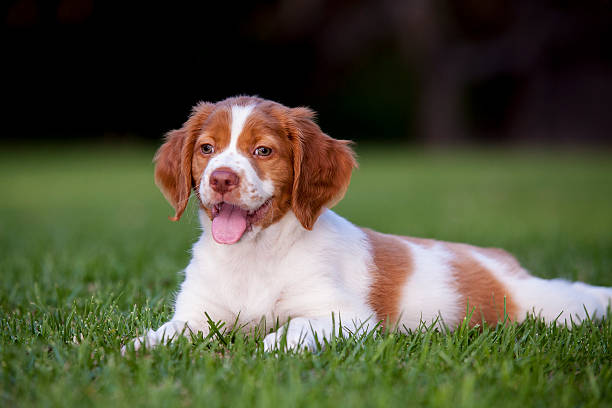Brittany Spaniel

Breed History:
The Brittany Spaniel, often simply called the Brittany, originated in the Brittany region of northwestern France during the 17th century. Developed by French hunters, it was bred to be a versatile gundog capable of pointing and retrieving game birds. Its agility, keen nose, and adaptability in dense terrain made it an invaluable hunting companion.
Originally classified as a spaniel, the breed’s hunting style more closely resembles that of pointers, leading many countries (including the U.S.) to drop “spaniel” from the name. The Brittany gained official recognition in France in 1907 and was later recognised by kennel clubs worldwide. Its popularity grew internationally for its intelligence, compact size, and enthusiasm in both the field and home.
|
Gender |
Height |
Weight |
|
Male |
48–51 cm |
14–18 kg |
|
Female |
47–50 cm |
13–17 kg |
Size – Medium
Life Expectancy: 12–14 years

Breed Appearance:
The Brittany Spaniel is a medium-sized, athletic dog with a balanced, compact build that reflects its stamina and agility. It has a slightly rounded head, high-set ears with moderate feathering, and bright, intelligent eyes—typically amber or hazel. Its tail is either naturally short or docked.
The coat is dense and flat or wavy, typically orange and white or liver and white, with patterns that can include ticking or roaning. Some Brittanys may be tricolour. Their clean lines and powerful gait reflect their dual nature as both a tireless hunter and a charming companion.
Breed Type – Family/Hunting Companion:
The Brittany is an energetic, friendly, and eager-to-please breed that excels both as a working gundog and a loyal family pet. It is sociable and affectionate, forming strong bonds with its family while remaining friendly toward strangers and other animals.
Known for its sensitivity and gentle disposition, the Brittany is especially well-suited to active homes. It prefers being part of the family’s daily routine and does best when included in both outdoor and indoor activities. Though not aggressive, it can be an effective watchdog, alerting to unfamiliar sounds without being overly vocal.

Training:
The Brittany is intelligent, responsive, and highly trainable. It thrives on positive reinforcement and is eager to learn, making it suitable even for first-time dog owners with consistent guidance. Its natural athleticism and willingness to work make it excel in obedience, agility, tracking, and field trials.
However, the Brittany is a sensitive breed that does not respond well to harsh correction. Early socialisation and exposure to various environments are important for developing confidence and preventing nervous or shy behaviour. With gentle, reward-based training, the Brittany quickly becomes a well-behaved, obedient companion.
Health & Care:
The Brittany is a generally healthy breed with few major hereditary concerns. Potential health issues include:-
-
Hip dysplasia
-
Epilepsy
-
Hypothyroidism
-
Ear infections (due to floppy ears)
-
Eye conditions like progressive retinal atrophy (PRA)
Maintaining a healthy weight and providing regular veterinary care are key to longevity. Clean the ears weekly to prevent infection, and keep up with vaccinations, parasite control, and routine checkups. With proper care, the Brittany is a resilient and long-lived companion.

Living Conditions:
The Brittany is best suited to active households, particularly those with access to outdoor space. It thrives in homes with large yards, farms, or areas where it can run and explore safely. While it can adapt to apartment living, it requires multiple daily walks and active playtime to remain healthy and content.
Because the Brittany is people-oriented and emotionally sensitive, it should not be left alone for extended periods. It enjoys being involved in family activities and performs best in homes where it's mentally and physically engaged throughout the day.
Exercise:
As a high-energy breed, the Brittany requires at least an hour or more of vigorous exercise each day. This can include walks, runs, fetch, off-leash play in a secure area, or structured activities like agility, field work, or hiking.
Without adequate activity, Brittany may become bored and develop destructive habits. Its intelligence and work ethic also mean it enjoys mentally stimulating games and training sessions. Active families, hunters, or outdoor enthusiasts will find the Brittany a perfect match for their lifestyle.
Grooming:
Brittany’s coat is relatively low-maintenance. Weekly brushing helps remove dirt and loose hair while preventing tangling in feathered areas. During shedding seasons, more frequent grooming may be needed.
Bathing can be done occasionally or after outdoor activities. Ear care is crucial—clean the ears regularly to avoid moisture buildup and infection. Trim the nails as needed, and brush the dog’s teeth several times per week to maintain oral health. Overall, Brittany is easy to care for with routine upkeep.

Advantages:
-
Intelligent, trainable, and eager to please
-
Friendly and affectionate with people and pets
-
Versatile working dog and devoted family companion
-
Low grooming needs
-
Excels in canine sports, hunting, and obedience
-
Medium size and adaptable nature
Disadvantages:
-
Requires significant daily exercise and mental stimulation
-
May develop separation anxiety if left alone too often
-
Can become destructive when bored or under-stimulated
-
Sensitive temperament—harsh training can be counterproductive
-
Needs regular ear cleaning to prevent infections
-
Strong prey drive—may chase small animals if not trained

